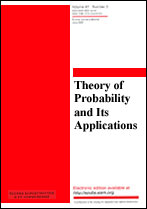|
This article is cited in 4 scientific papers (total in 4 papers)
Large deviations for a terminating compound renewal process
G. A. Bakay
Steklov Mathematical Institute of Russian Academy of Sciences, Moscow
Abstract:
Let $(\xi(i),\eta(i)) \in \mathbf{R}^{d+1}$, $i \in \mathbf{N}$, be
independent and identically distributed random vectors, let $\xi(i)\in
\mathbf{R}^d$ be random vectors, let $\eta(i)$ be improper nonnegative random
variables, and let $\mathbf{P}(\eta(i) = +\infty)\in(0,1)$. It is assumed
that the distribution of the vector $(\xi(1),\eta(1))$ subject to
$\{\eta(1)<+\infty\}$ satisfies the Cramér condition. By a terminating
compound renewal process we mean the process $Z_T =\sum_{k=1}^{N_T}\xi(k)$,
where $N_T = \max\{k \in \mathbf{N}\colon \eta(1)+\dots+\eta(k) \le T\}$ is
the renewal process corresponding to improper random variables $\eta(1),
\eta(2), \dotsc$. We find precise asymptotics of the probabilities
$\mathbf{P}\bigl(Z_T\in I_{\Delta_T}(x)\bigr)$ and $\mathbf{P}(Z_T = x)$
in the nonlattice and strongly arithmetic cases, respectively; here
$I_{\Delta_T}(x)=\{y\in\mathbf{R}^d\colon x_j\le y_j < x_j+\Delta_T$,
$j=1,\dots,d\}$, and $\Delta_T$ is a positive function converging sufficiently
slowly to zero.
Keywords:
compound renewal process, large deviations, the Cramér condition, terminating renewal processes.
Received: 19.08.2019
Revised: 12.06.2020
Accepted: 26.07.2020
Citation:
G. A. Bakay, “Large deviations for a terminating compound renewal process”, Teor. Veroyatnost. i Primenen., 66:2 (2021), 261–283; Theory Probab. Appl., 66:2 (2021), 209–227
Linking options:
https://www.mathnet.ru/eng/tvp5342https://doi.org/10.4213/tvp5342 https://www.mathnet.ru/eng/tvp/v66/i2/p261
|


| Statistics & downloads: |
| Abstract page: | 288 | | Full-text PDF : | 50 | | References: | 35 | | First page: | 4 |
|




 Contact us:
Contact us: Terms of Use
Terms of Use
 Registration to the website
Registration to the website Logotypes
Logotypes








 Citation in format
Citation in format 
